German National Prize for Art and Science
Through statutes of 30 January 1937,[1] the German National Order for Art and Science (German: Der Deutscher Nationalorden für Kunst und Wissenschaft)[1] was an award created by Adolf Hitler as a replacement for the Nobel Prize (he had forbidden Germans to accept the latter award in 1936 after an anti-Nazi German writer, Carl von Ossietzky, was awarded the 1935 Nobel Peace Prize). The prize was to be awarded each year to three outstanding German citizens who would receive 100,000 Reichsmarks which could be equally divided.[1] Along with the prize money the recipient also received a certificate with the Order.[2]
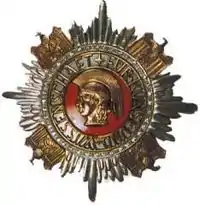
The Order, a round four pointed platinum star, with four gold National Eagles attached was designed by sculptor Müller-Erfurt, Berlin.[1] It was to be worn on the left breast. In the centre is a medallion with a red enameled centre with the gold head of Pallas Athene. On an ivory coloured enameled background in gold letters was the inscription FÜR KUNST UND WISSENSCHAFT (For Art and Science). This was surrounded by diamonds set in a gold border.[2]
The total number of National Prizes awarded between 1937 and 1939 was nine, making it the rarest award given in Nazi Germany. Due to the outbreak of the Second World War in Europe, no further awards were made.
Awardees
The German National Prize was awarded to nine people.
1937
The award announcement was held on 7 September 1937 and the award ceremony took place on 30 January 1938 by Adolf Hitler in the Reich Chancellery. The first five winners were:[3]
| Birth | Death | Laureate | Notes | Posthumous? | Shared monetary award? | |
|---|---|---|---|---|---|---|
| 1878 | 1934 | 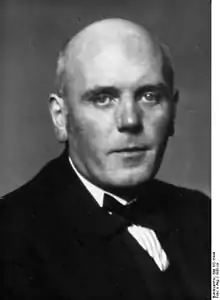 |
Professor Paul Troost | German architect; designed the Führerbau and Haus der Kunst. | ||
| 1893 | 1946 | 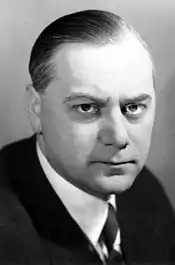 |
Dr Alfred Rosenberg | Reichsleiter; author of The Myth of the Twentieth Century, a key Nazi ideological work[2] | ||
| 1861 | 1949 | 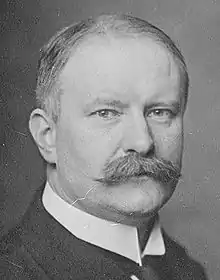 |
Professor August Bier | Surgeon and the first to perform spinal anesthesia and intravenous regional anesthesia. Shared the monetary award with Ferdinand Sauerbruch.[2] | ||
| 1875 | 1951 |  |
Professor Ferdinand Sauerbruch | Surgeon and developer of the Sauerbruch chamber, a pressure chamber for operating on the open thorax, and new types of limb prostheses, which for the first time enabled simple movements to be executed with the remaining muscle of the patient. Shared the monetary award with August Bier.[2] | ||
| 1877 | 1957 | 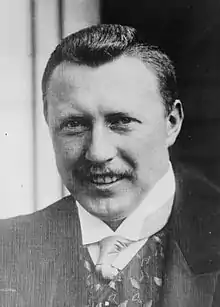 |
Professor Wilhelm Filchner | German explorer and discoverer of the Luitpold Coast and the Filchner-Ronne Ice Shelf. | ||
1938
The award announcement was made on 6 September 1938, the presentation by Hitler took place 30 January 1939 in the Chancellery. The winners of this second year were:[4]
| Birth | Death | Laureate | Notes | Posthumous? | Shared monetary award? | |
|---|---|---|---|---|---|---|
| 1891 | 1942 |  |
Dr Fritz Todt | German engineer, Inspector General of the German Highway System and founder of the Organisation Todt.[2] | ||
| 1875 | 1951 |  |
Professor Ferdinand Porsche | German automotive engineer and creator of the Volkswagen.[2] | ||
| 1888 | 1958 | 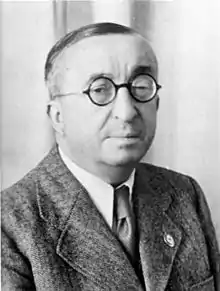 |
Professor Ernst Heinkel | German aircraft designer and producer of the Heinkel He 178, the world's first turbojet aircraft and the Heinkel He 176, the world's first rocket aircraft. Shared the monetary award with Willy Messerschmitt.[2] | ||
| 1898 | 1978 |  |
Professor Willy Messerschmitt | German aircraft manufacturer and designer of the Messerschmitt Bf 109, the most produced fighter aircraft in history. Shared the monetary award with Ernst Heinkel.[2] | ||
See also
Notes
- Doehle 1995, p. 35.
- Doehle 1995, p. 37.
- Nimmergut 2001, p. 1915
- Nimmergut 2001, p. 1916
References
- Doehle, Heinrich (1995) [1943]. Medals & Decorations of the Third Reich: Badges, Decorations, Insignia. Reddick Enterprises. ISBN 0962488348.CS1 maint: ref=harv (link)
- Jörg Nimmergut: Deutsche Orden und Ehrenzeichen bis 1945. Band 4: Württemberg II – Deutsches Reich. Zentralstelle für Wissenschaftliche Ordenskunde, München 2001, ISBN 3-00-001396-2; S. 1910–1917.